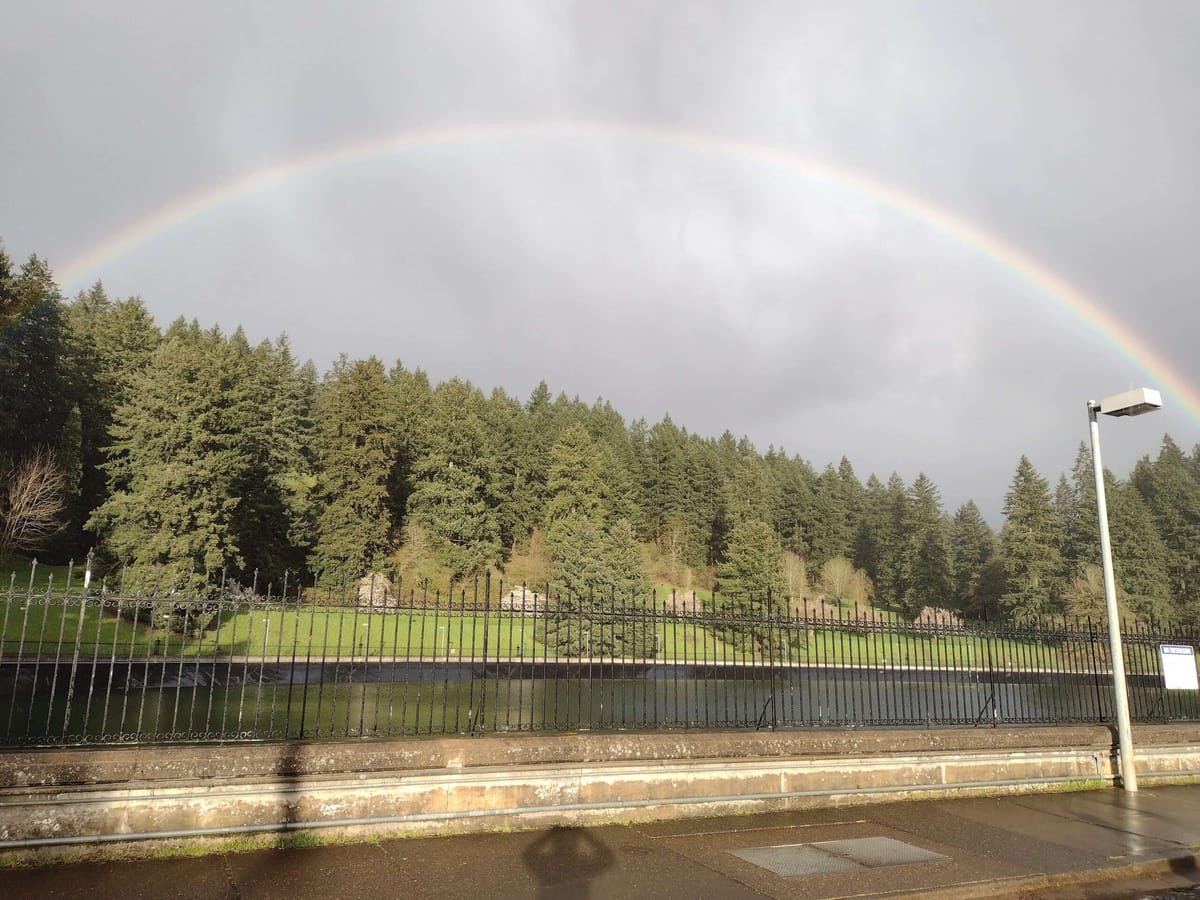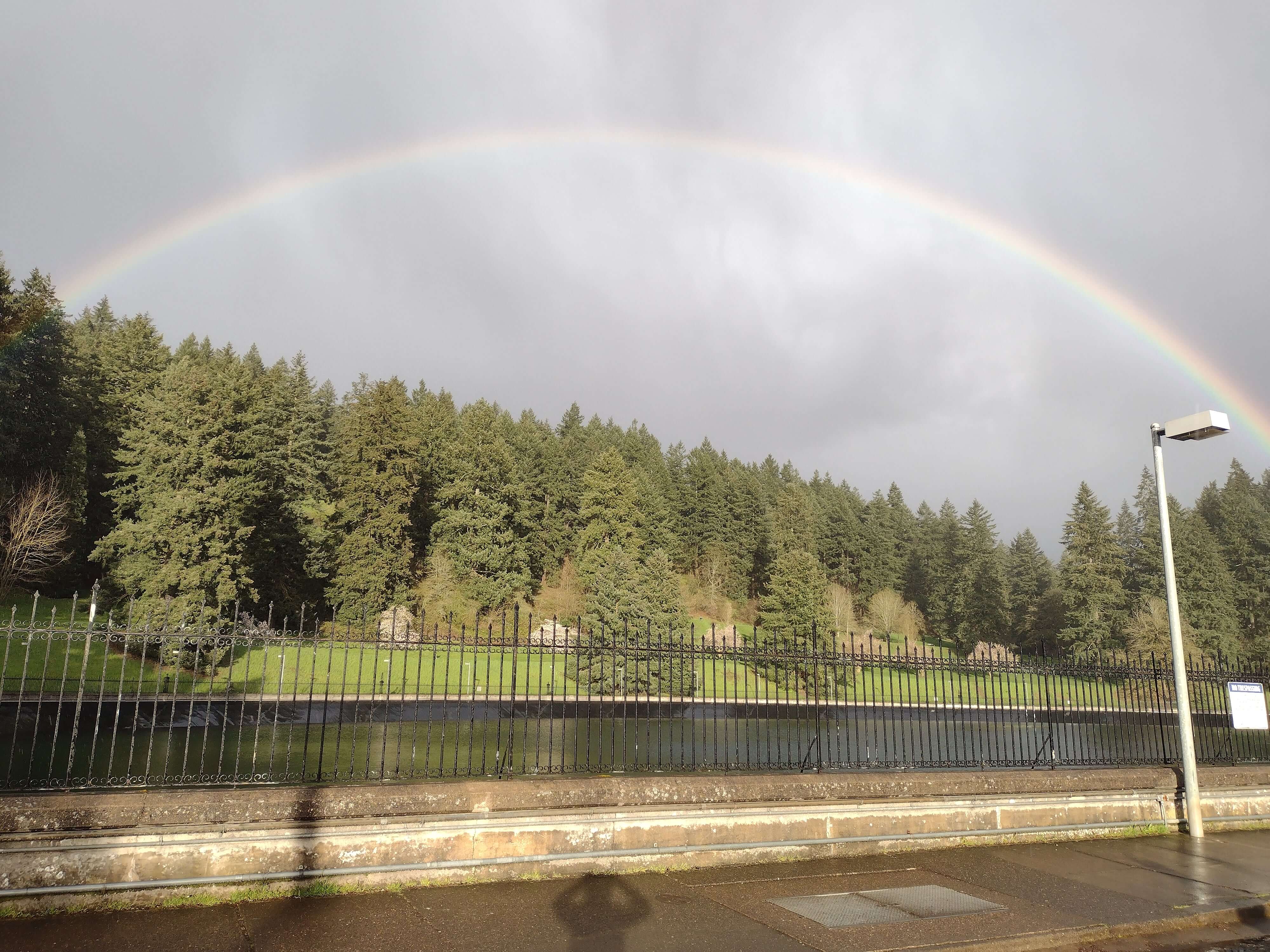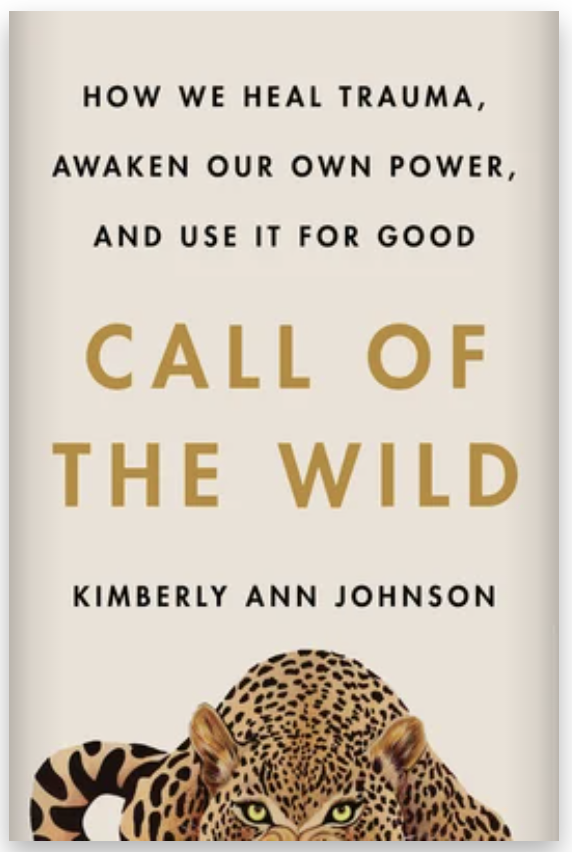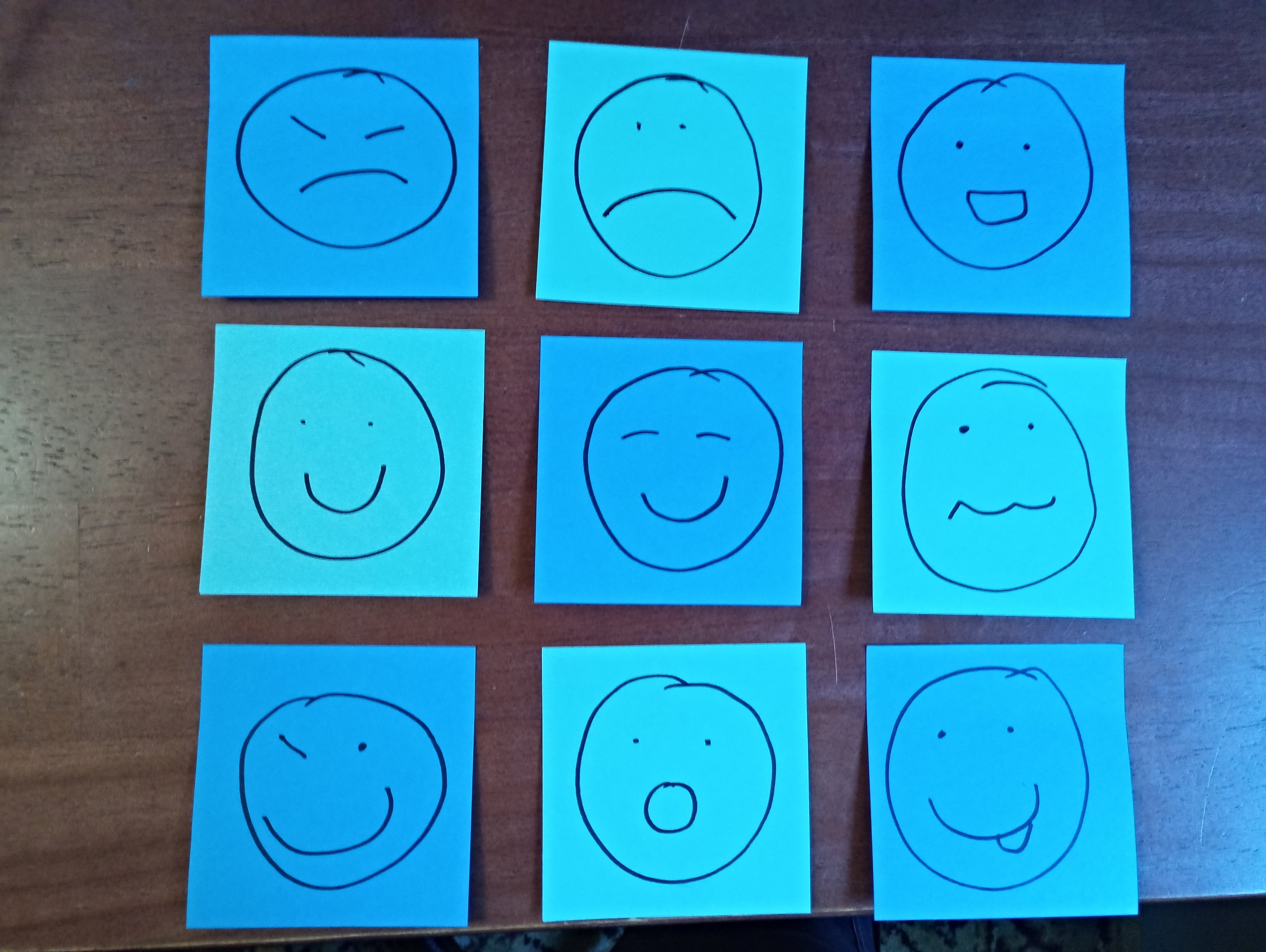Moment of Mind Spring 2023
If you're in the U.S. you may be celebrating Black history month. My favorite daily readings curated by Black people making history now is from Antiracism Daily [https://eagywq.clicks.mlsend.com/te/cl/eyJ2Ijoie1wiYVwiOjI3MTkzOCxcImxcIjo4MTI5OTY2Nzc0ODM5MDE1OSxcInJcIjo4MTI5OTY3NzY2NzkxOTQ5OX0iLCJzIjo


Image of rainbow in a park near my house. There were two, I just couldn't get them both in the screen.
Moment of Mind
"There's always a yes somewhere, even if it's to a no." - Candida Kraus quoting one of her dance/movement therapy teachers, quoted with permission.
These last few months I've been exploring how resistance shows up. How does it happen? What does it feel like? What are the sensations beneath it? When it stops, what's going on there?
You may recall in a prior newsletter I did an activity demonstrating what is called physical bracing...and then also supporting what was happening instead of resisting it.
In the video I clenched my fist firmly, as though to protect something. This is a form of constriction that the body engages in when there's a belief (unconscious) of "I can't handle this" or "I am bad" or "this is bad."
When I tried to pull my closed, gripped fingers open with my other hand it was painful because the grip was so tight, resisting.
Then, instead of using force, I felt what it was like to gently support, to hold, that closed fist with my other hand.
I felt into the muscles of the closed hand, how they were gripping, in which direction, felt the temperature of the skin, etc.
As I felt with one hand what was going on with the other I noticed a subtle loosening in the gripped fist.
Just like the clenching wasn't conscious, the gentle softening wasn't either. It was a nervous system response that showed up outside of conscious willpower in the body.
In my experience, we don't heal through willpower. Or from thinking.
This was a demonstration of the physical body's constriction and release cycles. It was one of many simple, yet insightful learning moments in the recent somatic therapy training I received.
I could see how when the body fights itself how much extra tension was present. When it's physical like this it is known as bracing and can be an impediment to muscle healing in situations like recovering from an injury.
There's an emotional belief component that can be intertwined with that physical bracing. The body can unconsciously physically brace against thought and emotions as they arise.
I could see how innocently the body might close up in protection from a belief in danger. Completely unconscious. A resource the body uses to handle things when capacity seems limited.
How wise of the body to learn to close up when it seems capacity is overwhelmed. This is related to how dissociation can also be a powerful coping tool the system uses when things are happening too fast or too big for where resources are in the moment.
The mind creates a representation of the physical body that it then protects, in the same way it protects the body from harm.
This idea of the body is what we call the self concept, or self identity. It isn't who you fully are, it's a projection, a representation of the body that's critical to development and survival. However when the mind believes that the idea of you is actually you things get wonky. Just like if you believe all the thoughts that show up are you...rather than you being the one experiencing the thoughts.
All the living, aware, beingness of you cannot be contained by this thin concept. Just like you cannot get wet from the word water as Alan Watts said, the idea of you can't actually be you. That representation also isn't the actual body. It's only an imagined version the brain uses to navigate in a physical, social, relating world.
The core you is the constant knowingness that happens before, during, and after every experience. It's what's experiencing reading these words right now. It's the you that doesn't know how these words are unscrambled and turned into meaning in the brain. There's no "you" doing that - it's just happening based on how the whole brain-body system learned. You are immeasurable and miraculous.
Yet the body will experience pain if this representation is perceived by the mind as threatened. Until there's an understanding that we are much more than just a mind representation.
I keep noticing how when my mind is in an anxiety loop how much other things are still happening - things like doing chores around the house, eating meals, etc. The anxiety loops play in the background as the system does the living of life.
While attention is glued onto the very real feeling projections the mind forecasts about the past or potential future the body braces against it. And then sometimes attention shifts back to the here and now, with the realization of oh, those thoughts aren't actually happening right now. That's just the mind doing it's creative thing in an attempt to be helpful. Because minds just do that. Like the way hearts just beat.
Just like physical bracing, when the mind attempts to force or control a stop to those mental gyrations...the system closes even tighter.
And sometimes this well intentioned attempt to fight against these negative beliefs can reinforce the existing closed pattern.
As above, so below they say.
I've been exploring mental patterns and how the mind (at least this one over here in this body) learned/absorbed/acquired a bunch of false beliefs of lack, of separateness from life, of smallness.
Then my friend shared a practice used in movement therapy one of her teachers taught her that mirrored the closed fist demonstration.
In somatics, liked in many spiritual traditions, we are encouraged to be with sensation, to feel the body, to be tune into feeling states and emotions.
The challenge with this guidance is that our minds are often conditioned to fear feelings, as though they are threatening to experience. And so telling someone to feel things the mind has created a grip of protective defense around ...well I bet you can guess what happens. The system just grips tighter, fights harder....resists. Seeks any escape from feeling.
Rather than an opportunity for healing now we may have a reinforcement of the underlying belief that is at play when the refusal to feel is going on.
If the belief is "I can't handle it" and the body clamps down harder to protect from the embedded message of lack that's in the belief...then it creates that very thing. Not handling it becomes a loop of negativeness about the self concept. Similarly people may reinforce a belief of "not enoughness" when they find they can't "control" emotions.
Our society seems to view natural variation in emotional sensations throughout the day as bad or wrong rather than normal and expected.
The body is absolutely capable of feeling all emotions. It's designed for them. Sensations and emotions are often signals of something to guide the conscious mind. And, avoidance of feeling is its own "handling" of things that's built in.
What Candida shared was to notice what's in the body when something like anxiety or hurt or resentment or frustration is happening. What are the sensations? Where is it? If it could talk what would it say?
Then see if you can say yes to it. Can you say yes to that sensation, feeling state, or emotion?
And If the answer is No, then can you say yes to that no?
Because there is always a yes somewhere, even if it's to the no.
This is the mental equivalent of gently supporting that closed tight fist in the demonstration I shared above. It's innocently in protection mode. It's no one's fault, it's a learned, subconscious pattern. It's part of the innate intelligence that you are.
So that's what I am doing and it is my invitation to you. I invite you to say yes to whatever is arising, and if you can't say yes to it, then say yes to the no.
sending love,
Tia

Love for Your Inner Science Activist Nerd
One of my favorite books last year, after Bodyfulness, is titled "Call of the Wild: How We Heal Trauma, Awaken Our Own Power, and Use It for Good" by Kimberly Ann Johnson.
What I appreciate the most about it are the diagrams she includes in the first few chapters that describe how the nervous system functions. I struggle to find ways to pare down complex information so that it's digestible - and she is fully sticking the landing.
She gives her own formula for being with sensations in the body that I appreciate because she layers in different research from somatics into an easy acronym. Each letter is a door or a "channel" of attention to tune into the body. Like dialing a radio. You can explore each in different circumstances to see what's easiest to access. And remember up above the most basic is to see if you can just notice any sensation, and say yes to it, even if it's a no.
Here is her acronym in brief, and I recommend the book for the exercises at the end of each chapter. Take them at your own pace. I skipped one whole chapter of practice because the feelings and sensations encompassed by them still feel very scary to this system based on the way the inner child developed.
TIMES: A Tool for Listening to the Body (pages 57-72)
Thought - The thought channel includes beliefs, judgments, thoughts and analysis. The author points out that we may be so fluent in this channel that we may keep the gear in it exclusively and give it too much weight. This can lead to excluding and minimizing the many other ways of knowing in our animal bodies (we human mammals remember, evolved over millions of years to exist in nearly all biomes on the planet). "We tend to believe our thoughts... we overidentify with our thoughts, confusing our ability to be aware of thoughts with the thoughts themselves." In this channel we begin to question the thoughts that show up and notice what state our nervous system is in. We may start to see that different nervous system activation levels are associated with thought patterns. As we inquire and support the body we also learn to not give as much weight to the thoughts as hard facts. If you've ever had thoughts that waffle back and forth you know what I'm talking about.
Image - Images are a form of energy in the body, like thought, that are sensory (e.g. sensory impression from what we can taste, touch, smell, see and hear) - internally generated or emerging from what our system gathers from outside through the senses. Just like our minds can create a velcro-like connection between sensations and beliefs, so can it create that magnetized stickiness between imagery and sensations. Our senses create impressions that our minds stores such as memories or dreams and can be used in storytelling. If feeling sensations in the body can feel overwhelming, then another practice ground is to use sensory images. For example you can visually see and hold an object and practice feeling it, smelling it, looking at it, and so on to waken up the senses.
Movement - The body is continually in motion, animated by the life that we are at the micro/cellular level al the way to the macro level. Various ways the body moves can have different meanings we've learned. Posture, physical movements, expressions, muscle tone, the body's carriage, and gait all can reflect habitual movement responses that may be related to processes that haven't had the opportunity to complete. For example when we are encouraged to "control" emotions through shutting them down and suppressing them those nervous system activations can become stored in the body and pop out when we least expect them. We may hold our bodies based on these locked movements. When they're given a chance to re-emerge and move all the way through in the witnessing presence that you are the body can change. Just like the exercise described above with a closed fist, we can intentionally use movement to notice patterns in the body and support its shifting.
Emotion - Emotions are the conceptual labels we've learned to give to a mix of underlying feeling states and sensations in the body. Our brain learns these concepts from the cultures we are in. Not all cultures label the same physical expressions as the same emotion. In one culture grief may look very different than in another culture. And the same expression can read as multiple emotions. A wide open mouth can be laughter, screaming, excitement or anger. Laughter can happen in fear or mirth. The brain uses current sensory inputs, past learned experiences, where our attention is, and the physical sensations in the body (called affect) to create emotions as predictions. Sometimes it can be challenging to know if you're excited, anxious, or you have indigestion because the nervous system is a key player in how the brain interprets sensations in the body to generate emotions. Emotions can be mixed and rapidly shifting. Emotions, and suppression of them, are a fertile ground to explore what the nervous system is doing, how to support it, and where there may be buried experiences that want to be released. Like thoughts, images, and movements, emotions are messengers about our nervous systems.
Sensation - The author refers to sensations as both the poetry of the body and its language. While I consider our body a musical instrument she thinks of it as a full orchestra, generator, and storehouse. Sensations are precursors to feeling states. She gives an appendix devoted to sensory words for learning to stay with sensation. For example somatic practitioners may ask you to notice a sensation and describe it based on size (small? big?), weight (heavy, bubbly), density (expansive, contracted), or even temperature (hot, cold, electric). Other sensations may include itchy, wiry, vibrating, hollow, bloated, dry and so on. And we can play with noticing how an emotion arises from sensations and what parts of the body are involved. For example she writes about someone experiencing anger as heat that emerges all over, and then rising from the belly to the throat and then into the head like a brushfire before a reaction happens.
What I've noticed with the TIMES acronym is that each channel helps us discover the continual motion of the body. None of this is easy because we've been conditioned to avoid the experiencing. Yet, through practicing observation I've notice the thoughts, images, movements, emotions and sensations are in nearly continual flux. In contrast, the awareness that we are is stable and unchanging before, between, and after each experience. I recommend it!
Get Your Park Groove On
I am currently recovering from an unexpected surgery (I'm fine, thank you). Forest bathing walks will resume in mid-June when I'm recovered.
Upcoming Events & New Offers

New Offering: Listen and Feel sessions
If you're wanting practice at feeling sensations or emotions as they emerge, these sessions are designed to support you.
Why bother?
Because limiting beliefs are reinforced through avoiding the feelings beneath them and they have the opportunity to dissolve in presence. Seeing who you truly are involves going through what you are not.
One access point for somatics is through what's called co-regulation between nervous systems. While I stay with the subtle shifts in my own nervous system, you can explore noticing what's happening in yours. I will listen and provide guidance to redirect your attention back to your noticing of your body and what's emerging. This isn't therapy, it's listening to the body and feeling it with a guide.
The first 30 minute session is free. Email me at info@findingmindfulnow.com to learn more.
| Copyright © 2019-2023, Finding Mindful Now LLC, All rights reserved. www.findingmindfunow.com, originally published on MailerLite with information on current offerings. Some images or content lightly revised since initial publishing. |
